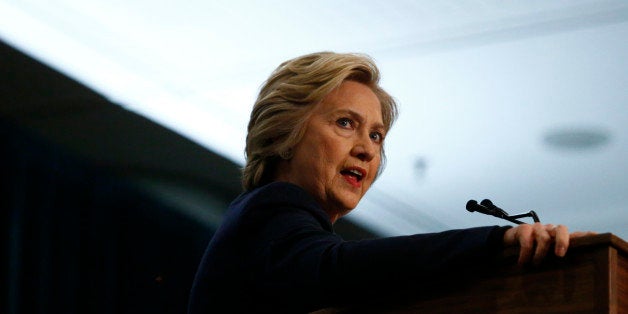
Last week, Vox writer Emily Crockett wrote a great article about gender bias in how we think about leadership. She reviewed the results of new political science research. "One experiment," she wrote, "just found that Clinton's gender could cost her as much as 24 points against Trump among male voters, and 8 points overall." Crockett went on to explain gender role expectations and threats, and the role that they play in voter perceptions. Studies reveal that simply asking questions that raise issues about challenges to traditional gender norms prime voters to feel threatened by powerful women who violate those norms. That effect, called gender priming, is far subtler than some alternatives, like the impact of overtly and graphically sexually objectifying women politicians to undermine their credibility or morality.
Studies show, conclusively, the role that gender, gender role expectations and traditional party structures play in suppressing women's leadership, particularly in electoral politics. A new one, Barriers and Bias: The Status of Women in Leadership, recently released by the American Association of University Women, takes a detailed look, covering gender and race, at the reasons women continue to be so greatly underrepresented in leadership roles in all sectors.
A similar 2015 study of more than 19,000 high school students, Leaning Out, Teen Girls and Leadership Biases, revealed how early this discrimination is already at play. Almost a quarter of teen girls -- 23 percent -- preferred male to female political leaders. That number was a staggering 40 percent for teen boys. While twice the percentage of girls said they preferred female political leaders than boys, the numbers were low -- eight percent of girls, four percent of boys. Fifty-six expressed no preference. Race was also highly salient. All students were most likely to support their white male peers in positions of leadership and least likely to support their white female peers.
SO, HERE'S THE TEST.
How'd you score?
My results "suggest a slight association of Female with Supporter and Male with Leader." And, I identify as a woman and a feminist, which increases the odds that I would not be biased against women leaders significantly. Men who aren't feminists have the highest resistance to the idea. A large segment of Millennial men are even more conservative than Genxers and routinely underestimate women and their professional and political abilities.
- Enduring discrimination, otherwise known as sexism
- Ambient environmental family, school or work hostility
- Profuse negative stereotypes about women in leadership
- Gender biases that associate power, authority and leadership with masculinity
- Institutional intractability that perpetuates the status quo
Your gender and race don't mean you can't be biases against your gender and race. In-group biases are common. Most people would balk at the suggestion that they are overtly sexist. Some admit to prejudices, and acknowledge that they have unconscious biases. When faced with a specific candidate, like Hillary Clinton, however, the most common response to why a person might not support her candidacy rarely takes these realities into account. "It's not because she's a woman, it's because INSERT REASON HERE." Excuses for not wanting Clinton to be president sound incredibly familiar to those mentioned for not wanting other women to be leaders. "She's not the right woman." "It's not the right time." "She's not credible." "She's not trustworthy." "I can't put my finger on it, but..." "I can't stand her husband," and more. There are legitimate reasons for not supporting Clinton, but they are, almost inevitably, only partially complete. She pays a very high price, as a candidate, for her lady genes. There are reasons why the U.S. ranks 95th in the world for women's national legislative political representation, and has never had a woman president, and it isn't because women aren't credible, able, trustworthy, moral, or have problematic spouses.
In the last '80s, Mahzarin R. Banaji, who was then an assistant professor of psychology at Yale University, found a way to study the implicit biases that we all have. At the time she was involved in a memory experiment, the end of which involved asking subjects, based on a list of names, which people were famous. The subjects routinely and incorrectly made "ordinary" men "famous" ones, but did not do the same when encountering women's names. Banaji was curious: Would the same thing happen if she changed male names like "Sebastian" and "Peter," to "Susannah" and "Penelope." In her initial experiments, she found that female names were far less likely to achieve fame in the same way. People, entirely unconsciously, herself included, did not treat women the same way they treated men. They could not say why and did not consider the simple change in gender to be the cause of the evident differences.
These biases don't only hurt the people we are "othering," but also can undermine people's own sense of self and their abilities, a phenomenon called stereotype threat, defined by researchers in 1995 as "the risk of confirming, as self-characteristic, a negative stereotype about one's group." So, for example, when African American students have to indicate their race on a test booklet, their test scores drop. The same thing happens when girls and women are asked to indicate that they are female. Simply removing the request for people to identify themselves prior to taking an AP calculus test improved test scores.
Banaji's work has, over the years, expanded to study other forms of common and unconscious bias and is, today, coming to some meaningful fruition. Banaji and two other professors, Tony Greenwald (University of Washington) and Brian Nosek (University of Virginia) started a nonprofit, Project Implicit, in 2001.
While it's very difficult, impossible, to entirely eliminate bias, it is possible to acknowledge it and reduce its effects at home and at work. Research suggests several approaches, including self-monitoring and evaluation and anti-bias training and education that work to create positive outcomes. There are also tech approaches. For example, Gap Jumpers offsets biases through blind interviewing and hiring processes. Of course, you'd have to want those outcomes to willingly participate.
